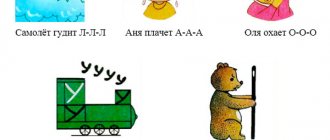Speech therapy is the science of speech disorders, methods of preventing, identifying and eliminating them through education and special training. Speech therapy studies the causes, mechanisms, symptoms, course, structure of speech disorders and the system of corrective influence.
At the Yusupov Hospital, speech therapists restore impaired speech functions using innovative techniques.
Principles and visual methods of speech therapy
When to contact a speech therapist? Adults need speech therapy rehabilitation after a stroke, traumatic brain injury, or brain tumors. Children need consultation with a speech therapist in the following cases:
- a child of one and a half to two years old does not pronounce the words “mom”, “dad”, “top-top”;
- the baby is silent until the age of three, although he understands speech addressed to him;
- the child is lagging behind in speech development;
- after traumatic brain injury;
- By the age of five, a child nasals, burrs, lisps, and pronounces sounds incorrectly;
- baby at five, the child doesn’t remember words well.
From the age of three, children are recommended to undergo an annual consultation with a speech therapist, even if their parents think that everything is fine. Intensive development of the cerebral cortex in children continues until the age of 6-7 years. It is better to deal with speech therapy problems before school, and it is worth starting early.
What is the difference between a speech therapist and a speech pathologist? A defectologist has a specialization in “defectology”. He works with children with physical and mental disabilities. A speech therapist works with children without mental retardation or disruption of the central nervous system. He teaches the correct pronunciation of sounds and syllables. The tasks of a speech therapist at school are the correction and prevention of reading and writing disorders.
Speech therapy is based on the following basic principles:
- consistency;
- complexity;
- development principle;
- consideration of speech disorders in relation to other aspects of the child’s mental development;
- the principle of taking into account the causes and mechanisms of speech defects.
Speech therapy methods are conventionally divided into several groups:
- organizational – comparative, longitudinal (study over time), complex;
- empirical – observation, experimental, psychodiagnostic (tests, questionnaires, interviews), biographical (collection and analysis of the patient’s life history);
- quantitative and qualitative analysis of the obtained data, their machine processing using electronic computers and computer programs;
- interpretative – methods of theoretical study of connections between the phenomena being studied.
Technical means that ensure the objectivity of the study are widely used: intonographs, nasometers, spectrographs, video speech, phonographs, spirometers and other modern equipment. X-ray film photography, cinematography, electromyography, glottography make it possible to study the dynamics of holistic speech activity and its individual components. Neurological problems are also studied in speech therapy.
The use of anticipation in teaching literacy in speech therapy classes
The use of anticipation in teaching literacy in speech therapy classes
The modern education system allows the child to become an active participant in the learning process. The success of learning in all subjects depends on the student’s general academic skills. One of the basic general educational skills is reading
, because The success of a child’s education in almost all subjects of the school curriculum depends on it.
A student who reads little and poorly will, as they say, “choke” in the flow of information. Therefore, in elementary school, teachers develop an optimal reading speed and a craving for reading fiction, educational, and educational literature. Often teachers use anticipation techniques.
Translated from Latin, “anticipation” (anticipatio) means predestination, anticipation, prediction of events; a preconceived idea about something. The term “anticipation” was introduced into psychology in 1880 by the German scientist Wilhelm Wundt. He understood by this term the ability of a person to imagine the possible result of an action before it is carried out.
The ability to anticipate, including anticipation when reading, can be trained. For a well-trained reader, the reading process resembles the game “Guess the melody.” From a few initial letters he guesses the entire word, and from a few initial words - the entire phrase, and from several phrases - the meaning of the entire paragraph or section.
With the help of anticipation (guess, mental anticipation), the reader runs ahead in thought. He not only understands what the author is talking about in the text being read at the moment, but also assumes, guesses, according to the logic of the development of the author’s thoughts, what he should say next. The reader turns into a kind of co-author. He himself “continues” the author’s text, he himself mentally “writes” the continuation. This position causes high intellectual activity, does not allow one to lose the thread of presentation, the author’s train of thought, helps to notice all deviations, all unexpected moves and shades, and involuntarily sets one in a critical mood in all cases of discrepancies between the guess and the actual train of thought of the author.
The question arises: is it possible to use this method of work in kindergarten in speech therapy classes when teaching literacy? After all, preschoolers do not yet have reading skills, they do not have sufficient “speech experience”! There is an opinion that it is necessary to develop anticipation when reading text when the child is already reading at a speed of 15-20 words per minute. But the anticipation of letters
can be developed already at the first, initial stage of literacy learning.
However, many speech therapists use this method when learning letters. Here are some working methods:
- Restore the letter from individual elements (games: “Bug-Eater”, “Add the letter”, “Correct the letter”, “Choose the right letter”, etc.)
Complete the letters so that they are all different
- Isographs are a real find for the development of visual perception, attention, memory, logical thinking, and creativity of preschoolers.
- Choose a given letter from a number of letters, syllables, words
- "Noisy" letters
- "Transforming a letter" from one to another
- Coming up with an “image of a letter” (draw it, show it with your fingers, using counting sticks, threads, etc.)
- Composing words from given letters and syllables
- Cut pictures (letters)
Completing letters by adding missing elements to them
Finding letters in combined letters
Thus, in kindergarten, during literacy classes, it is possible to use techniques to develop anticipation for the material of letters, which will help children in their further education at school.
MB preschool educational institution “Kindergarten No. 91”, Novokuznetsk
Speech therapist teacher: Kozyreva O.V.
Classification of general speech underdevelopment in speech therapy
In terms of clinical composition, the category of children with general speech underdevelopment is heterogeneous. Speech therapists distinguish the following forms of pathology:
- uncomplicated forms of general speech underdevelopment in children with minimal disorders of brain function - insufficient regulation of muscle tone, immaturity of the emotional-volitional sphere, motor differentiation);
- complicated forms of OHP in children with psychopathic and neurological syndromes - cerebrasthenic, convulsive, hypertensive-hydrocephalic, hyperdynamic;
- gross underdevelopment of speech in children with organic lesions of the speech parts of the brain (with motor alalia - the absence or underdevelopment of speech in children with normal hearing and initially intact intelligence).
The following classification of speech disorders in speech therapy is currently used:
- the first level of speech development is “speechless children” who lack common speech;
- the second level of speech development - the initial elements of common speech, a poor vocabulary, and the phenomena of agrammatism are determined - speech disorders manifested in difficulties in generating or perceiving sentences;
- the third level of speech development is the appearance of expanded phrasal speech with underdevelopment of its semantic and sound aspects;
- the fourth level of speech development – residual gaps in the development of the lexical-grammatical and phonetic-phonemic aspects of speech.
Features of treatment
There is no universally recommended treatment algorithm for perseveration. Therapy is carried out based on the use of a whole range of different approaches. One method should not be used as the only method of treatment. It is necessary to take new methods if the previous ones did not produce results. Roughly speaking, treatment is based on constant trial and error, which ultimately makes it possible to find the optimal method of influencing a person suffering from perseveration.
The presented methods of psychological influence can be applied alternately or sequentially:
- Expectation.
It is the basis in psychotherapy for people suffering from perseveration. The point is to wait for changes in the nature of the deviations that have arisen against the background of the use of various methods of influence. That is, the waiting strategy is used in conjunction with any other method, which we will discuss below. If no changes occur, switch to other psychological methods of influence, expect results and act according to the circumstances. - Prevention.
It is not uncommon for two types of perseveration (motor and intellectual) to occur together. This makes it possible to prevent such changes in time. The essence of the technique is based on the exclusion of physical manifestations that people most often talk about. - Redirection.
This is a psychological technique based on a sharp change in ongoing actions or current thoughts. That is, when communicating with a patient, you can suddenly change the topic of conversation or move from one physical exercise or movement to another. - Limitation.
The method is aimed at consistently reducing a person’s attachment. This is achieved by limiting repetitive actions. A simple but clear example is to limit the amount of time a person is allowed to sit at a computer. - Abrupt cessation.
This is a method of actively getting rid of perseverative attachment. This method is based on the effect of introducing the patient into a state of shock. This can be achieved through harsh and loud phrases, or by visualizing how harmful the patient’s obsessive thoughts or movements or actions can be. - Ignoring.
The method involves completely ignoring the manifestations of the disorder in a person. This approach works best if the disorders were caused by attention deficit. If a person does not see the point in what he is doing, since there is no effect, he will soon stop repeating obsessive actions or phrases. - Understanding.
Another relevant strategy with which the psychologist recognizes the patient’s train of thought in case of deviations or in the absence of them. This approach often allows a person to independently understand his thoughts and actions.
Perseveration is a fairly common disorder that can be caused by various reasons.
When perseveration occurs, it is important to choose a competent treatment strategy. Medication is not used in this case.
Speech stereotypies, also known as speech iterations, verbal tics, are reflexive, meaningless and emotionally indifferent repetitions of sounds, syllables, words and entire phrases in the patient’s speech.
The patient’s speech can be either on his own initiative or provoked by questions from people around him.
Manifestations
Based on the nature of perseveration, the following types of its manifestation are distinguished:
- Perseveration of thinking or intellectual manifestations. It is distinguished by the “settling” in the human creation of certain thoughts or its ideas, manifested in the process of verbal communication. A perseverative phrase can often be used by a person when answering questions to which it has absolutely nothing to do. Also, a person with perseveration can pronounce such phrases out loud to himself. A characteristic manifestation of this type of perseveration is constant attempts to return to the topic of conversation, which has long been stopped talking about or the issue in it has been resolved.
- Motor type of perseveration. Such a manifestation as motor perseveration is directly related to a physical disorder in the premotor nucleus of the brain or subcortical motor layers. This is a type of perseveration that manifests itself in the form of repeating physical actions repeatedly. This can be either the simplest movement or a whole complex of different body movements. Moreover, they are always repeated equally and clearly, as if according to a given algorithm.
- Speech perseveration. It is classified as a separate subtype of the motor type perseveration described above. These motor perseverations are characterized by constant repetition of the same words or entire phrases. Repetition can manifest itself in oral and written form. This deviation is associated with lesions of the lower part of the premotor nucleus of the human cortex in the left or right hemisphere. Moreover, if a person is left-handed, then we are talking about damage to the right hemisphere, and if a person is right-handed, then, accordingly, to the left hemisphere of the brain.




